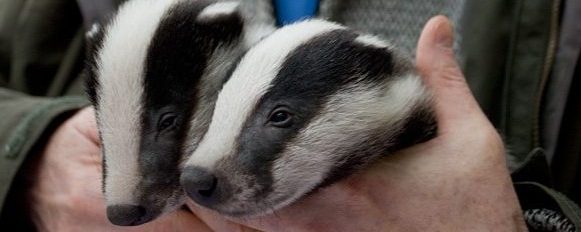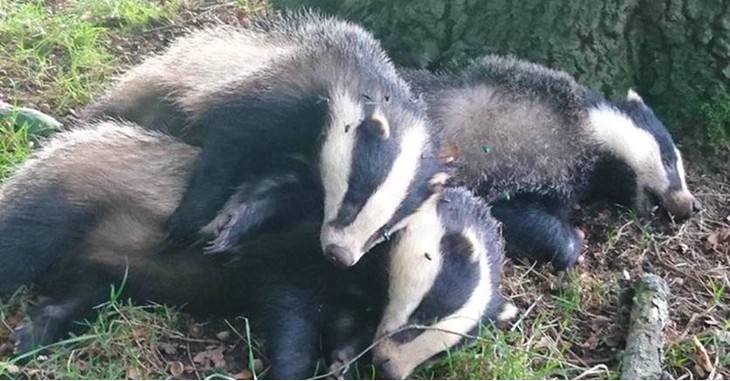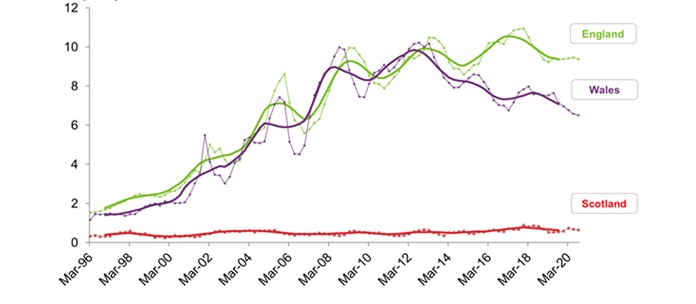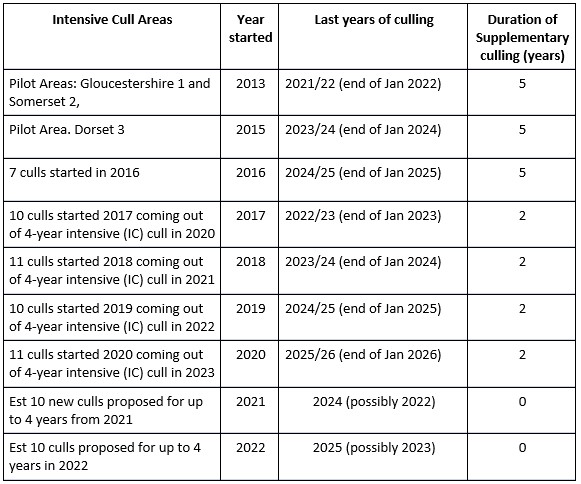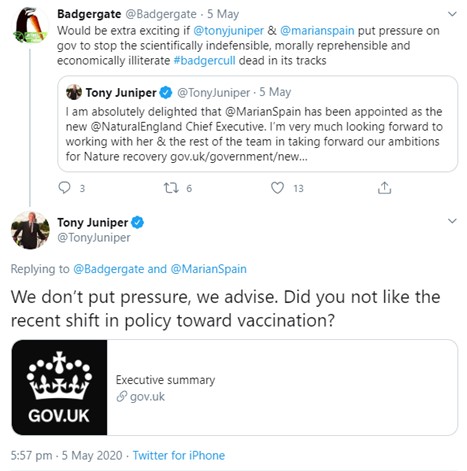Revised 27th April
Defra closed the 27th January consultation without allowing time to consider the implications of the 10th March data release. They have said they will respond to points raised by 6th April and the matter is now being considered by legal experts. Here are extracts from a consultation response by Tom Langton, based upon use of government data to show what has really been happening in the High Risk Area since 2010.
As further analysis is done, the results will be sent to Defra and Natural England and published. Meanwhile we expect the government to correct its mistaken view that badger cull is working and not to issue any further badger cull licences in 2021.
Bovine tuberculosis: consultation on proposals to help eradicate the disease in England. A consultation exercise contributing to the delivery of the government’s strategy for achieving bovine tuberculosis free status for England. “Next Steps” (March 2020) Policy Consultation.
The SSEFRA Minister’s statement of 27th January 2021
There is a fundamentally misleading and erroneous statement which features in, and indeed underpins, the consultation proposals. The Secretary of State’s Parliamentary statement of 27 January 20213 states that badger culling “…has played a critical role in helping to start turn the tide on this terrible disease.”
This is the justification for continued use of ‘intensive’ and ‘supplementary’ badger culling, as described in the current consultation. This statement has been widely repeated in the media in recent months and also by a range of government officials including the Chief Veterinary Officer. It underpins, and influences, the current consultation. The consultation itself asserts that “the current cull policy has been effective” (8.1) and refers in Figure 1. to Gloucestershire, Somerset and Dorset.
The consultation proposes that new rounds of badger cull licences will be issued authorising the culling of badgers for the next six years and beyond. It is estimated that a further 150,000 badgers may be culled under these proposals: as many or more, as have been killed to date. The risk of serious consequences to the farming & nature conservation stakeholders and to the public purse of getting the policy wrong and perpetuating the disease are obvious.
Recent communications on fair time for consideration.
Promptly after release of data on 10th march and while the consultation was still running, my representatives wrote to Defra and Natural England to ask that they postpone it and re-consult once the information and the Ministers view provided (as above) have been corrected. This was both to ensure that a fair and lawful consultation is concluded and to ensure that the Secretary of State’s proposals are based on a proper understanding and articulation of the evidence. In light of the matters set out below, a decision to adopt badger culling policy without reviewing these matters would be liable to be quashed on an application for judicial review.
Specifically I refer to release of key information on bovine TB (bTB) statistics on 10th March 2021, just ten working days before the closure of the consultation that showed significant variance from the Ministers position. This is unreasonable, and an initial look at the data released in the time allowing shows it to be both extremely important and to lead to conclusions that contradict the wording of the Ministerial statement on 27th January.
More reasonably, a minimum of 6-8 weeks should be allowed in order to consider the data properly. It’s use, I believe would result in a very different conclusion to the Ministerial statement and one of sufficient substance that would otherwise make the consultation unfair and invalid, should the current basis for the consultation be retained.
Further key points
1. Whilst the proposal to cease supplementary badger culling (SBC) is in principle welcomed, its continuance for a further five years, to February 2026, alongside intensive badger culling is completely unjustified and unacceptable given the new information.
2. Our letters to Natural England in relation to the licensing of SBC dated 8 March 2019 and 29 May 2019 refer to Prof. Boyd (CSA) describing the need for an ‘adaptive approach to policy development’. According to Prof. Boyd, badger culling will “often not work as predicted” and so an “operational control” method is needed, based upon “outcomes”.
3. Natural England, in its internal deliberations on the uncertainties of evidence when licensing culling, (Paper by Dr Tim Hill to Natural England Board meeting of 6 November 2019, released to Mr Langton under FoI in August 2020. RFI 5049) has noted:
“7.1. As implementation of the culling policy has progressed a series of evidence needs and gaps have emerged. Culling is taking place over an expanding area of England and, as we advised in 2010 and 2011, it means the Government is increasingly less able to rely on the evidence base provided by the RBCT. Implementation of the policy has also identified operational challenges for which the existing evidence base is proving unsatisfactory. Finally, intensive culling was never proposed as the long-term solution to controlling TB in badgers and – particularly in light of the Godfray Review – we need to revisit the available evidence to inform future strategies.”
4. Further, Natural England has identified in a letter dated 18 June 2019 the need for results from six badger cull areas, for at least four years in order to gain any initial insight into disease control trends. That requirement was achieved in respect of intensive culling, once the 2016 four-year intensive culls concluded in 2019, with a further year observation period of herd breakdowns to 2020. It was, in part upon the above clarifications, that the matters raised in my 2019 pre-action protocol letter were not pursued.
5. It follows that the real time outcomes in bTB control as measured in ‘cases per area, per year’ have become the definitive point of reference since the scale and nature of culling has moved well beyond that assessed in the RBCT. Such data tells farmers and vets in each cull area and across intervention areas what is actually happening, with an increase or decrease in bTB herd incidence and residual prevalence.
Preliminary view relating to available data
6. Difference between confirmed breakdowns of bTB in cattle herds, within and outside of the badger cull areas over the badger cull duration: 2013-2019 in the HRA are consistent with relatively small background fluctuations. They do not support the public claims by the Minister of an “effective” cull policy, using theoretical modelling (consultation paras 8.1-8.3) relating to 2017 and before.
7. At the county level, breakdowns began to level off after 2010 when the HRA was placed on annual bTB testing. Other measures were progressively introduced from 2012. Importantly, in 2016 the interpretation of the SICCT test was changed too, to detect more disease. A raft of other measures to slow the incidence of bovine TB in cattle were slowly introduced within the HRA and are also relevant.
8. Changes to the rate of confirmed breakdowns in the HRA will have been brought about by cattle measures beginning to have an influence, commencing well before the badger culling roll-out started. For the government to use the average figure for herd breakdowns for the four years prior to culling commencing as a benchmark is wholly inappropriate. It fails to have regard to the relevance of factors other than culling, in the same period, affecting the chosen measure. Any realistic comparison should be from the point at which badger culling commenced. Using the four-year average prior to the start of culling is wholly misleading. The figures have been misused to present a positive view of the culling when effectiveness is clearly open to question when: (a) a comparison is made with unculled areas, and (b) the effect of other changes in bTB control have been contemplated.
9. This is further demonstrated by additional observations of how the trend in bTB herd incidence is almost exactly the same in places where herd measures have been applied and where they have been applied together with badger culling at the County scale.
10. Other counties are being looked at carefully and hence the need for more time prior to consultation ending and the request in my letter of 18th March 2021 and subsequent clarifications.
11.The reality of these trends is in stark contradiction to key findings of the now out of date modelling of badger cull efficacy: the publications Brunton et al. 2017 and Downs et al. 2019 (using data only up to 2017) . This is the basis upon which SSEFRA has previously relied to imply progress in 2017, albeit on heavily modelled results, with caveats as to the reliability of the findings.
12. For these reasons, there is grave concern not just that theoretical modelling has not reflected the subsequent long term face-value evidence, but that the real time data on the full period 2013-2020 has been misrepresented to the public by the Secretary of State, both in public statements and in the current consultation process.
13. This is of very significant concern because of the manner in which the consultation has been worded to imply that badger culling has had a substantial positive effect in real terms. The only fair analysis from the existing data is that it remains uncertain as to whether there has been any benefit from badger culling at all. The consultation fails to grapple with this uncertainty and the evidence that it has been of no value at all.
14. This finding is consistent also with previous considerations of the CSA (in June 2019) that any contribution of badger culling to bTB new herd incidence will never be measurable in any event. That doubt, from the CSA, is also not alluded to in the consultation document.
15. The assumed effectiveness of culling as a means of bTB control is central to the consultation proposals. It is both put forward as an explanation of the Government’s proposed approach to licensing, and it purports to inform consultees of a factual basis upon which they should respond to the consultation. Once that proposition is put into doubt, it is apparent that the Government’s proposed approach is undermined and that the consultation process has been rendered unfair by the false claim.
16. Further, the present state of the evidence cannot conceivably support the grant of further intensive culling licences. Licences granted on the false assumption presented in the consultation paper would not be lawfully granted in accordance with Section 10 of the Protection of Badgers Act 1992.
Steps that Defra should take
In light of the above, the following steps should be taken:
- Correction of the misleading information in Paras 8.1 – 8.3 and elsewhere of the consultation in relation to the effectiveness of culling from the evidence held to date. That correction should include an explanation of the comparison with non-culled areas, and an explanation of the factors other than lethal badger control which might have affected bTB incidence in the study periods;
- The Secretary of State should extend the consultation period by sufficient time to correct the current information and to make public statements to reflect the position in (a) above;
- That there is a further consultation period on such amended proposals as the Secretary of State makes having properly directed himself on the matters set out above;
- That no further badger cull licence applications are processed until a public position is set out by the Secretary of State on the effectiveness of such licensing, having regard to the matters set out above.
Tom Langton 24th March 2021.
References:
https://questions-statements.parliament.uk/written-statements/detail/2021-01-27/hcws738
https://www.gov.uk/government/publications/bovine-tb-incidence-of-tb-in-cattle-in-licenced-badger-control-areas-in-2013-to-2019
https://www.gov.uk/government/statistical-data-sets/tuberculosis-tb-in-cattle-in-great-britain;
https://www.tbknowledgeexchange.co.uk/
Click to access bovinetb-statsnotice-Q3-quarterly-16dec20.pdf
https://ec.europa.eu/food/sites/food/files/safety/docs/cff_animal_vet-progs_2013_dec-2012-761-ec_bovine-tuberculosis_gbr.pdf – No longer available online.
Brunton LA, Donnelly CA, O’Connor H, Prosser A, Ashfield S, et al. (2017) Assessing the effects of the first 2 years of industry-led badger culling in England on the incidence of bovine tuberculosis in cattle in 2013-2015. Ecol Evol p. 1-18.
Downs, S.H., Prosser, A., Ashton, A. et al Assessing effects from four years of industry-led badger culling in England on the incidence of bovine tuberculosis in cattle, 2013–2017. Sci Rep 9, 14666 (2019). https://doi.org/10.1038/s41598-019-49957-6
Annex 1. Further information on relevant cattle measures responsible for changing leftes of new herd incidence.
Area 32 Cumbria
“Recent published raw data shows encouraging trends of reduced incidence and prevalence across the first 32 cull areas compared with the years before culling began. Compared with the average of the four years before culling started, OTFW incidence has dropped by an average of 27% after 2 years, 51% after 4 years and 53% after 6 years in the first twenty-one, three and two areas respectively.”
Area 32 Cumbria had achieved OTF status before the onset of culling 2018 and so Cumbria has been wrongly included in the above calculations. Furthermore, having removed almost the entire badger population from the extended Area 32, ibtb mapping shows there are currently 5 ongoing breakdowns in the area, all of which became restricted between 8/10/20 – 29/10/20. The epidemiology history of Area 32 does not provide support for wildlife being drivers of disease.
European (EU) undertakings
In order to understand the effects and benefits of cattle controls newly introduced into the High Risk Area from 2012 to-date and there is need to examine a report submitted by Defra to the European Commission
The submitted Eradication Programme for Bovine Tb provided a whole raft of measures to improve the control of disease. The most notable of which was the introduction of annual testing in England from January 1st 2013.
In England, a core annual testing area was established, spanning entire counties in the South West and West Midlands (the ‘high risk area’) and surrounded by a ‘buffer’ of two- yearly testing parishes. Most of the rest of England remains on background four-year testing.
Herd testing intervals are determined on a county basis and England is split into annual testing and four-yearly testing counties.
Enhanced measures were introduced in 2014 to address the problem of persistent herd incidents. Mandatory IFN-γ tests are also used in persistent incidents where herds have been under restriction for more than 18 months.
Published the joint government-industry Bovine TB Biosecurity Action Plan. https://www.gov.uk/government/publications/cattle-biosecurity-action-plan-for-improving-herd-resilience-to-bovine-tb
Stopped the practice of de-restricting parts of some TB-restricted (non-OTF) holdings.
https://www.gov.uk/government/publications/bovine-tb-information-note-ending-the-practice-of-de-restricting-parts-of-tb-restricted-holdings
Tightened pre-movement testing rules by removing remaining exemption for cattle moved between holdings that are part of the same Sole Occupancy Authority(SOA).
https://www.gov.uk/government/publications/bovine-tb-information-note-changes-to-tb-cattle-movement-controls-exemptions
Tightened pre-movement testing rules by removing exemption for movements to and from common land.
https://www.gov.uk/government/publications/bovine-tb-information-note-changes-to-tb-cattle-movement-controls
Introduced an enhanced approach for dealing with persistent bTB breakdowns.
http://apha.defra.gov.uk/documents/ov/Briefing-Note-0214.pdf
2015
Further measures were adopted in the HRA during 2015 which sustained the reduction of incidents following the success of previous measures:
-Introduced improved IT data capture system for epidemiological investigation outcomes to support targeted enhancement of more sensitive testing regimes in the HRA.
-Promoted new guidance to cattle farmers (agreed with key industry groups) on how to protect their herd from bTB through implementing improved bio-security on farm – the Five Point Plan.
-Extended reduced CAP Scheme payments (cross-compliance penalties) for overdue bTB tests to include all types of TB tests with very few exceptions.
https://www.gov.uk/government/publications/bovine-tb-information-note-tb-testing-changes-for-cross-compliance-penalties-and-surveillance-tests
2016
Improved testing and cattle controls: In the HRA: introduced requirement for two consecutive clear short interval tests at severe interpretation by default for all bTB breakdown herds before they can regain OTF status.
https://assets.publishing.service.gov.uk/government/uploads/system/uploads/attachment_data/file/506575/tbin-0216-breakdowns-high-risk-area.pdf
Phased out SOAs and Cattle Tracing System Links between summer 2016 and summer 2017 and reviewed controls on cattle movements within a 10-mile radius of home premises (‘CPH England’ project).
2017
Tighter controls on cattle movements were introduced, together with severe interpretation extended to cattle traced from breakdown herds.
- Increased the sensitivity of skin testing of cattle traced from lesion/culture positive bTB breakdown herds by applying the severe interpretation of the SICCT test.
- Tightened rules for licensed movements of cattle between two bTB breakdown herds.
- Harmonised the timing of short interval skin tests in bTB breakdown herds, so that tests are scheduled at least 60 days from the date of reactor removal, rather than the date of detection.
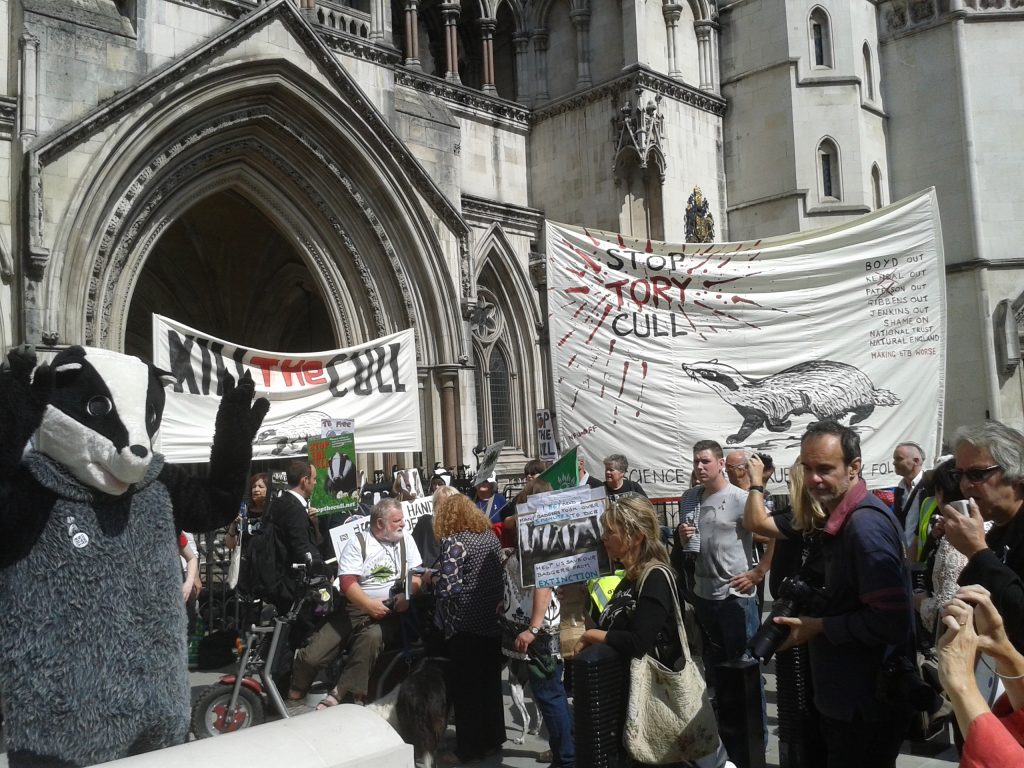 Firstly, the Legal Challenge fundraiser for the NERC Act 2006 case has passed its first target of £8,000 in just over a week. Great going. Huge thanks to everyone who has donated, promoted the campaign and put the appeal out on social media over the last few days, especially the Badger Trust. Badgers and biodiversity have friends everywhere.
Firstly, the Legal Challenge fundraiser for the NERC Act 2006 case has passed its first target of £8,000 in just over a week. Great going. Huge thanks to everyone who has donated, promoted the campaign and put the appeal out on social media over the last few days, especially the Badger Trust. Badgers and biodiversity have friends everywhere.
